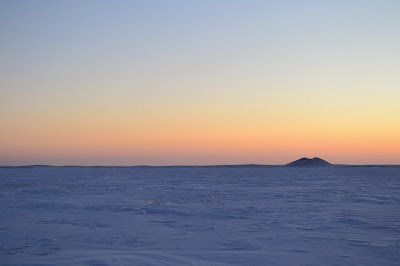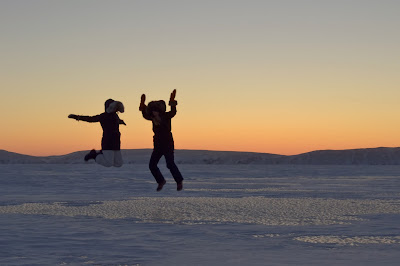48 hours and 8 airports ago, we said goodbye to Inuvik. And net +45 degrees Celsius later we are in Hawaii, kicking back to enjoy the elusive sun and 2 weeks of vacation.
Our last week in Inuvik was full of mixed emotions. We have been looking forward to planning a vacation in Hawaii since moving west to BC. At the same time, we have really grown to feel at home in Inuvik over the past 3 months, and will miss the amazing people we have met there.
Did Inuvik meet all our expectations? I would say: absolutely. I can admit I had built up the experience in my head after my short month there as a medical student, and I was worried it wouldn't live up to the way I remembered it. I was also worried Adam wouldn't like it! But to have my best friend and partner here with me this time around was incredible. We worked hard, but also made friends, got out in the community, acted and felt both like tourists and locals at times, and gained an infinitely more complex understanding of the north and it's people. We went dogsledding, stood in awe under the Aurora, drove on a frozen river, walked on the arctic ocean, ate reindeer for Christmas dinner, felt the softness of a shorn beaver pelt and the wiry hair of a polar bear, purchased beautiful local crafts, became acclimatized to -30degree weather and wore snow pants to the bar.
Is there anything we left undone? Well, the one thing I missed out on was getting out 'sledding', or snowmobiling. I've never yet been on a snow machine! But this week did give us the gift of one more incredible night of northern lights, the best we'd seen since that first weekend back in November! And this time our camera battery was charged. As we walked back from a late dinner of wings at Shivers on Wednesday night, we noticed the start of some green in the sky above us. We borrowed the keys to the hospital van, rallied the troops (the other residents and a young locum doc here), and drove down the Dempster until the lights of town were behind us. And we were rewarded with this:
Our last week in Inuvik was full of mixed emotions. We have been looking forward to planning a vacation in Hawaii since moving west to BC. At the same time, we have really grown to feel at home in Inuvik over the past 3 months, and will miss the amazing people we have met there.
Did Inuvik meet all our expectations? I would say: absolutely. I can admit I had built up the experience in my head after my short month there as a medical student, and I was worried it wouldn't live up to the way I remembered it. I was also worried Adam wouldn't like it! But to have my best friend and partner here with me this time around was incredible. We worked hard, but also made friends, got out in the community, acted and felt both like tourists and locals at times, and gained an infinitely more complex understanding of the north and it's people. We went dogsledding, stood in awe under the Aurora, drove on a frozen river, walked on the arctic ocean, ate reindeer for Christmas dinner, felt the softness of a shorn beaver pelt and the wiry hair of a polar bear, purchased beautiful local crafts, became acclimatized to -30degree weather and wore snow pants to the bar.
Is there anything we left undone? Well, the one thing I missed out on was getting out 'sledding', or snowmobiling. I've never yet been on a snow machine! But this week did give us the gift of one more incredible night of northern lights, the best we'd seen since that first weekend back in November! And this time our camera battery was charged. As we walked back from a late dinner of wings at Shivers on Wednesday night, we noticed the start of some green in the sky above us. We borrowed the keys to the hospital van, rallied the troops (the other residents and a young locum doc here), and drove down the Dempster until the lights of town were behind us. And we were rewarded with this:
 |
| Our co-resident and his partner |
Moral of the story? It's always a good idea to get wings on a wednesday night at 10pm.
We have been asked a lot this week whether we would consider coming back to work in Inuvik. Would I locum there? Absolutely. I think a few months locuming in Inuvik after our PGY-3 year would help remind us how to practice good generalist medicine, and would be a well-supported environment in which to get back into running family practice clinics. Hopefully our acquired experience with Ultrasound and emergency medicine would also add something to the team in Inuvik as well.
Would we ever sign a longer-term contract there? That's a more difficult question. On one hand, the medicine in Inuvik is fascinating. The collegiality is unrivalled and the hospital environment is friendly. There is the opportunity to practice, and really become proficient at a much broader scope of medicine than almost anywhere else. There is a sense of adventure to it, and we actually enjoy the town. We have already proven we need very little in our lives to be happy - a few good friends, a fulfilling job, an activity or two to distract from work, maybe a coffee shop and a pub, and each other. Finally, the salary and benefits the hospital offers it's physicians on a 3-year contract is very, very appealing.
But there are a few things that I think would be difficult for me to come to terms with about truly living in Inuvik. For one, it is hard to truly integrate into the community. Southerners always are viewed as outsiders, and for good reason. There is such a transient population in town, the local people must get incredibly tired of the revolving door of people landing in, making their cash, and leaving again. One longer-term physician here says it took at least 5 years, and having kids involved in the schools and community activities, before she felt like people opened up to her. There is almost an 'ex-pat' feel to the community of southerners we befriended, almost all of whom were working in the hospital and has been living in Inuvik for under 5 years.
The other thing that has been increasingly bothering me about life in the north is the absolutely enormous carbon footprint of each person living here. Everything sold here - food, clothing, building materials, household items, really everything except for the odd caribou or fish harvested by the minority of locals who still go out on the land - has been driven or flown thousands of km for our consumption. And then is discarded on the land. Garbage never makes the return trip out, and I can't imagine there is much time for decomposition of the trash during the short summers. Composting is out of the question, and recycling facilities are unavailable. Furthermore, there is no possibility of a real landfill with the permafrost. Years worth of waste is simply piled on the land outside town. I imagine the town dump would be an interesting place to pick through, and would tell the story of the commodification of northern life over the past 50 years. 'Sustainable' living is an oxymoron here. The fact there is a community greenhouse, with small plots available to be planted by families in the summertime, is a nice gesture, but we are long past the days of living off the land. Even if anyone was interested in giving up today's standard of living and returning to the old way of life, most of the knowledge seems to have been lost.
Heating homes also takes a ridiculous amount of energy, the production of which is currently reliant on natural gas and propane driven up the Dempster highway. Everyone in town seems to drive a big truck, which makes some sense in this environment, considering the roads and ice they must navigate, but these gas guzzling machines will be left running in town for hours on end. Vehicles obviously have block heaters here, because below -20 there is a real risk the car will not start. But it seems to be the norm to leave the truck idling, keys in the ignition, while the driver runs any kind of errand, or even if the car is parked at home for any length of time between outings. I had one patient I saw in the emergency room for a minor illness, and after she had been there for over an hour already, between waiting to be seen and waiting on bloodwork to return, she came to ask me how much longer it would be and if she should go turn her car off. It had been running in the parking lot the whole time. With the price of fuel at $1.75/L you would think the cost would be a deterrent to this wastefulness. But I guess getting into a nice warm car is attractive too?
The whole issue of the sustainability and energy consumption of northern living seems to be a bit of a taboo subject. The implicit message being: am I suggesting that communities such as Inuvik should cease to exist? That the population should just choose to move south to where it makes more 'sense' to live? This would be ignoring the fact that while some of us (southerners) can choose to pick up and leave any time we want, for people with roots in the north, this is their home. Culturally, a strong sense of wellbeing is tied to both the land of their ancestors and to the value placed on family and community. This is what keeps the soul healthy. But will this always be the case? The nature of the land is changing, and is expected to do so with disproportionate speed as the globe warms, the permafrost melts and the seas rise. What will be the impact of this transformation?
Southern living is not necessarily any less environmentally harmful, and on a macro scale it is the industry of the south, which we are all complicit at driving, which is contributing most to the global carbon footprint. And on a personal level, I admit to not always making environmentally conscious decisions. Case in point being the 7 hour flight to Hawaii for pure pleasure that we just took. But in my day to day, I like to have the choice to try to minimize my impact by buying local, cycling, reducing my consumption and waste, and envisioning a world where someday we do not rely on fossil fuels. And I do have the luxury of choosing where I live. For the sake of adventure and a good salary, can I justify ignoring these realities?
As for any of the challenges that face the north, there are no easy answers.
But I will admit that the north has captured our imaginations, and at some point, for however long, I'll bet we will be back.
Thanks for following along with us! Quyanainni.















































